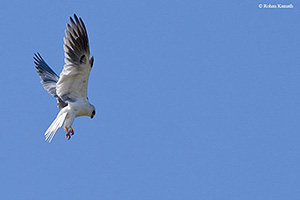Hovering Flight |
|
|---|---|

 photographs of a White-tailed Kite and Anna's Hummingbird by Rohan Kamath |
Some
birds, such as kestrels, remain motionless "wind hovering"
above a point on the ground by flying into the wind at a
speed equal to that of the wind, and other birds hover
momentarily while foraging. Hummingbirds, on the other hand,
are able to remain in the same place in still air as long as
they wish -- they are true hoverers. A hovering hummer keeps
its body at about a 45 degree angle to the ground and moves
its wings in more or less a figure-eight pattern, with the
"eight" lying on its side. Hummers have an extremely mobile
shoulder joint, permitting them to twist the wing in such a
way as to generate lift on both the backward and the forward
strokes. The front edge of the wing leads on both strokes,
and on the backstroke it is the underside of the feathers
that face upward, the shoulder rotation having, in effect,
turned the wing upside down. In each stroke the bird is able
to make use of some of the energy transferred into the
motion of air on the previous sweep of its wings. For
instance, on the forward stroke the airspeed of the wing is
increased because it is traveling through air pushed toward
the rear of the bird by the previous backstroke. The
direction of thrust changes between the forward and backward
strokes, so that they cancel each other out. Since the wings
beat more than 20 times per second (sometimes as rapidly as
80 beats per second), inertia holds the bird's body
essentially stationary. This system makes hummingbirds extremely maneuverable and permits them to hover while they extract nectar from flowers that might otherwise be inaccessible. But the hovering flight is quite expensive: about 30 percent of the total body weight of |
| hummingbirds is invested in the breast muscles (which power the wings), whereas other strong-flying birds have about 20 percent, and weak fliers may have only about 15 percent. The hummers would require an even greater investment in muscle if it were not for the way that their wings are always moving through air accelerated by the previous wing stroke. | |
| SEE:
Adaptations for Flight;
Wing Shapes and Flight. Copyright ® 1988 by Paul R. Ehrlich, David S. Dobkin, and Darryl Wheye. |
|